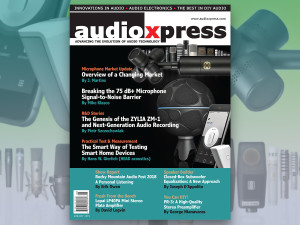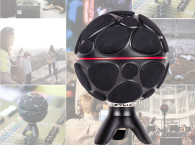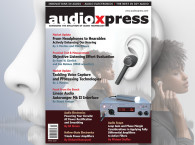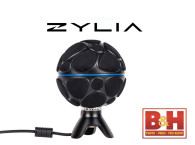 The January 2019 edition of audioXpress is here and kick starts the year with a strong issue, which will be heavily distributed at CES 2019. First, we recommend you read our editorial on why these are Exciting Times to be in Audio! A positive message that will provide a brighter perspective for times ahead.
The January 2019 edition of audioXpress is here and kick starts the year with a strong issue, which will be heavily distributed at CES 2019. First, we recommend you read our editorial on why these are Exciting Times to be in Audio! A positive message that will provide a brighter perspective for times ahead.And starting strong means keeping up to date with the trends. For this edition, we have worked on a Microphone Market Update. In "Overview of a Changing Market," J. Martins provides an overview of the microphone market and summarizes what the technology actually entails and how it is evolving—and more important, its convergence, which is as significant as other more closely watched components. The report addresses the latest innovations from traditional microphone brands for stage and studio, the latest microphone modeling technology trends, new spatial audio and Ambisonics microphones, a look at the wireless microphone market, and how new microphone concepts and new mass-market technologies such as MEMS, propelled by the popularity of smartphones and smart speakers, are actually creating a space for new microphone applications, from communications to media production.
On "Breaking the 75 dB+ Microphone Signal-to-Noise Barrier," Mike Klasco looks at the latest cutting-edge microphone technologies, from MEMS to graphene and optical microphones, and discusses the optimum signal-to-noise ratio, the market current status, and where it's headed.
To complement this month's Microphone report, we also have interesting testimony from Piotr Szczechowiak, co-founder and COO at Zylia, a startup company from Poland, which is getting noticed for its ZM-1 spherical microphone array. The ZM-1 records and separates each instrument and vocals into a separate track using an innovative and patented recording sound-source separation technology, combining dedicated software and cloud processing. The ZM-1 is also generating growing interest for its potential use in spatial audio production, gaming audio, virtual reality, and even audio measurement and conferencing applications. The company has now announced a series of software releases that significantly expand its potential uses, including an Ambisonics Converter and source localization software. In this article, Szczechowiak explains how Zylia got there.
And while microphones are one of the key technology contributors for voice recognition applications, according to a study by npr & Edison research (Fall/Winter 2017), 65% of smart speaker users wouldn't want to go back to life without it, 71% are listening to more audio since getting one, and 64% want to have the same voice recognition experience in their car. This illustrates the market momentum for smart "devices." But these systems must also be tested to the highest requirements in order to ensure an optimal voice and audio quality meets users' expectations. In "The Smart Way of Testing Smart Home Devices - Automated Tests and True-to-Reality Simulations that Take Crucial Factors into Account," Hans W. Gierlich, managing director of HEAD acoustics, explains how to test the different performance parameters of these systems under real-life conditions, how to deal with the challenges of optimizing systems for voice and audio quality, how to simulate environmental conditions, user behavior, and test the performance of the various functionalities.
And because we like to recognize and appreciate great sounds, audioXpress asked Erik Owen to provide his unique insight on what stood out at the Rocky Mountain Audio Fest (RMAF) 2018. During his explorations of great sounding two-channel stereo systems, Erik Owen shares information about products he found interesting, innovative, and inspiring at the Denver, CO, show. As he explains, "Fifteen bucks buys a one-day pass, then you hit the stairs (since not all the elevators work) to the 11th floor. I give one minute to each room, and if I’m not captivated, I move on. I don’t sit down, and I don’t drink scotch when offered. I own a small hi-fi shop in Gig Harbor, but what I really want to see at RMAF is something that sounds so good it will become part of my life. I don’t think that is too much to ask."
Next up, David Logvin, explores the Lepai LP40PA ultra-compact amplifier, a versatile Class D common plate amp module with fully integrated Bluetooth 4.2 receiver and 3.5 mm stereo inputs, ideal for converting existing passive speakers into convenient portable and wireless units that can be placed anywhere. Parts Express provided audioXpress with this plate amplifier for review, and it seems that building powered speakers is easier than ever with these Class D plate amplifiers. At least, the Lepai LP40PA has plenty of power for a pair of bookshelf speakers as Logvin experimented.
 And because we know how our readers like to get hands-on with DIY projects, this month we include a new project for a High-Quality Stereo Preamplifier from George Ntanavaras. In this article, Ntanavaras describes the design and the construction of a stereo analog preamplifier that he calls the PR-3, offering three high-level unbalanced stereo inputs and two unbalanced stereo outputs. Most of the components for this design are contained on a single PCB, and the amplification stage is based on a top-quality single op-amp - the Texas Instruments OPA627 - supplied with very low noise regulators.
And because we know how our readers like to get hands-on with DIY projects, this month we include a new project for a High-Quality Stereo Preamplifier from George Ntanavaras. In this article, Ntanavaras describes the design and the construction of a stereo analog preamplifier that he calls the PR-3, offering three high-level unbalanced stereo inputs and two unbalanced stereo outputs. Most of the components for this design are contained on a single PCB, and the amplification stage is based on a top-quality single op-amp - the Texas Instruments OPA627 - supplied with very low noise regulators.And this month, audioXpress is honored to publish the latest contribution from Joe D’Appolito. In "Closed-Box Subwoofer Equalization: A New Approach," D'Appolito explains step by step how to address the equalization of closed-box subwoofers using a state variable filter (SVF), which relates directly to the desired equalizer response with values that are easily calculated, while the circuit has a lower passive component count. Advantages of addressing the equalization of closed-box subwoofers in this way also include slower low-frequency roll-off allowing for better room coupling, in generally smaller enclosure volumes.
Get your copy of audioXpress right now. This is an edition you don't want to miss out. Now available on print and online at: www.gotomyxpress.com
And of course you can also subscribe here: www.audioxpress.com/page/audioXpress-Subscription-Services.html
If you wish to buy a single printed issue or the complete audioXpress archive on USB, from 2000 to 2019 (yes, including the latest issue), just visit our online shop at www.cc-webshop.com






